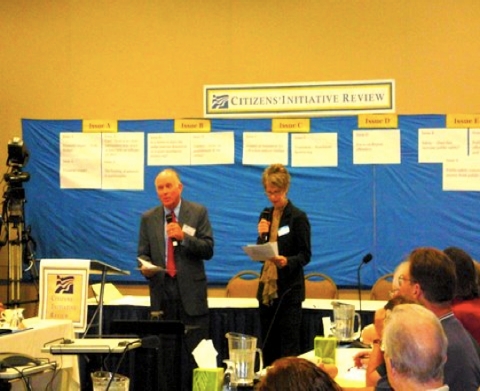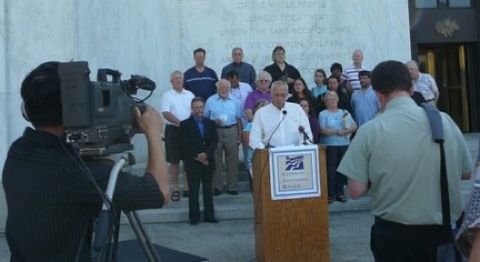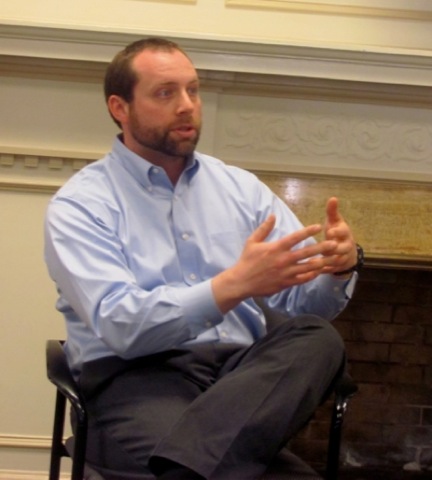In many jurisdictions around the world, voters have the power to propose laws directly through ballot initiatives. For its advocates, this element of direct democracy is an essential part of the idea that the power of government truly lies with the people. For its critics, there is one fundamental problem: the initiative process allows citizens to act as legislators without giving them the basic tools that are available for elected representatives, like access to independent data, to experts and to committees that have examined the issues, or the opportunity to deliberate with others about the pros and cons of the proposed laws.
This creates a situation where powerful groups can run a campaign based on partial or misleading information and persuade voters to pass legislation that puts significant burdens on the state or that does not necessarily promote the common good.
Is there a way to preserve the democratic benefits of ballot initiatives while reducing their shortcomings? The answer to this question may be found in a remarkable new use of deliberative democracy in Oregon that helps citizens see the entire picture, weigh the different arguments, and check the accuracy of the alleged facts before they vote. In the “Citizens’ Initiative Review,” now passed into law and an integral part of the initiative process itself in Oregon, randomly selected citizens hear both sides of the issue, consult with experts, deliberate among themselves, vote on the initiative, and write a short statement that summarizes the arguments for and against. This statement is included in a ‘voters’ pamphlet’, which is distributed to the electorate before the elections so voters can know what a randomly selected panel of citizens thought on the initiative, and why.
[image_2_small_right]Elliot Shuford is co-director of Healthy Democracy Oregon, a nonprofit organization that in the last five years has been implementing and refining the Citizens' Initiative Review. He has worked as a performance auditor for the State of Oregon, and had internships with US Senator Mark O. Hatfield and the Department of Human Services. He was a member of Portland’s Citizen Campaign Commission that assisted the city with its publicly financed election system. Elliot enjoys climbing and back-country skiing, and this led him to become a member of Portland Mountain Rescue. He also has training in several methods of group process and has worked as a professional facilitator. When he pursued a Master’s of Public Administration at the University of Oregon, he became interested in new democratic processes and met Tyrone Reitman, with whom he co-founded Healthy Democracy Oregon.
In March of 2012, Elliot Shuford participated in a colloquium on deliberative democracy organized by the Participatory Governance Initiative of Arizona State University. In this interview with Participatory Governance Initiative co-director Daniel Schugurensky, Elliot recounts the history of the “Citizens’ Initiative Review,” explains how it works, and shares some of the main lessons learned. He argues that ballot measures are often complex issues that have significant financial and social implications for taxpayers.
Given that the stakes are so high, campaigns and interest groups spend millions on campaign tactics like poll-tested messages and sound bytes to shape the debate to their advantage. Their goal is to get votes, and their tactics are primarily meant to influence, not necessarily to inform. He notes that to exercise responsibly the right to participate in direct democracy, voters should have reliable and clear information about ballot measures.

Daniel Schugurensky: What is the Citizens’ Initiative Review?
Elliot Shuford: The CIR is a model of public deliberation that seeks to give voters access to more trustworthy and accurate information about ballot measures. More than that, it is a totally different way of doing politics.
How did it start?
We can trace it back to the seventies, to the work of Ned Crosby and Patricia Benn at the Jefferson Center, which is a nonpartisan nonprofit based in Minnesota. They developed and tested something called The Citizens Jury. This provided the basic model for the CIR. They brought together a group of 24 randomly selected citizens to deliberate about topics of public concern, from local issues like local farming practices all the way to national issues like the Clinton Healthcare Plan.
Was this deliberation connected to policy decision-making?
Not as much as the Jefferson Center had hoped. In The Citizens’ Jury there was no direct tie to decision-making. There was an expectation that the well-reasoned, thoughtful recommendations from a group of representative citizens would carry legitimacy and weight for decision makers.
How was the transition from these citizens’ juries to the CIR?
In the 1990s, the Jefferson Center was applying the Citizens Juries to electoral candidates to serve voters. In Washington State, some leaders made the recommendation that they could use this model to evaluate ballot initiatives. Crosby, Benn and others started to develop this idea, which eventually became what is called today, the Citizens Initiative Review. That’s about the time I met Crosby and Benn.
When was that?
I met Ned and Pat in 2000, at a talk they gave in Oregon. They presented the concept of the Citizens Initiative Review, and I was excited because I thought that they were going to do something in Oregon with it. I was ready to volunteer! Then I lost touch with them for a while and didn’t think that they were going to pursue this idea further, but in 2004 a friend of mine named Tom Atlee, sent me an email with 10 ideas for electoral reforms that he was promoting. One of them was the CIR, and that kept me interested in the concept.

What were you doing at that time?
I was a graduate student in Planning, Public Policy and Management at the University of Oregon. There I met a classmate named Tyrone Reitman, and shared these reform ideas with him. While in graduate school, we had a lot of very lively discussions about these ideas and political change in general. Two years later, in 2006, as I was getting ready to hike for 6 months on the Pacific Crest Trail, I got an email from Ty asking me if I knew if anybody was working on the CIR. At that time, he was working on two ballot initiative campaigns and became increasingly frustrated about how voters were shortchanged by the initiative process.
What were his main concerns?
He realized that people are not empowered by these initiatives the way they could be. He noticed that the facts on the measures that he was working on were not part of the public conversation. Many people would sign an initiative without giving much thought about it, and the campaigns for and against would resort to sound bites to persuade the electorate, but there was never real deliberation. He remembered our discussion on the CIR, and thought that it may be a great improvement to the initiative process. I told him that I could probably track down Crosby and Benn and see if they were still working on this idea.
Were they?
Fortunately they were still interested in implementing this idea, and were actually trying to do it in Washington State. I contacted them, and set a meeting between the four us in Castle Rock, Washington, which was half way between our respective residences, at a terrible little diner. Nothing concrete and solid came out of that, but we got to know each other better and it seemed that Ty was very committed to work on it.
And you?
I went to Mexico to start my hike of the Pacific Crest Trail, which I finished hiking in October, so I was back in Oregon for the November 2006 elections.
[image_3_small_right]What happened next?
After that election, Ty started to do some research on whether we could run an initiative campaign to create the Citizens Initiative Review in Oregon. We proposed a plan to Ned and Pat, who decided to fund the initial stages of lobbying the legislature and perhaps running the initiative campaign A few months later, we decided to take a slower and more methodical approach.
Why was that?
The legislature, initiative advocates, and others told us: “We want to see how this model works.” So, we decided that it was appropriate to start with a demonstration or field test to apply this idea in a real-world setting.
What was this field test about?
The subject of the review, which took place in September 2008, was a ballot measure to limit English as a Second Language Instruction in Oregon. We brought a panel of 24 randomly selected citizens to deliberate about this measure for five days, from 9 am to 4 pm. The panel was balanced demographically by age, gender, ethnicity, education level, party affiliation, and place of residence.

How did you recruit these participants?
We started with a random sample of 10,000 voters. We sent them a letter inviting them to apply to the CIR. From those who express an interest, we created a pool of several hundred potential participants, and from that pool we selected 24, taking into account the six demographics factors that I just mentioned.
When you were selecting the last 24 participants, how do you avoid accepting or rejecting people who you may know?
In that final selection, when we moved from several hundred people to the final list of 24, we only knew participants by numbers. We didn’t have access to their names. We also invited initiative advocates, legislators and other groups to participate in the selection process, which was held as a public process.
How did you remove some of the costs of participation?
We provided a daily stipend of just under $150, which was the average wage in Oregon at that time. In addition, we provided a transportation stipend, accommodation, food, and a stipend for childcare. Participants understand from the beginning that this is a public service to convey useful and balanced information to voters.

How did the field test work out?
The process worked very well. The advocates for and against, the panelists and the League of Women Voters all agreed that the process was essentially fair and free from bias. At that point we knew that we were in a good position to promote the model.
How did you promote the model?
In 2009 we spent several months lobbying the legislature again, this time for an official pilot, with the results published prominently in the statewide voters’ pamphlet. We also wanted to have an independent evaluation of the process. The legislature agreed, and we started to organize and fundraise for the 2010 elections. We were fortunate to receive support not only from Ned and Pat, but also from the Saling Foundation as well as from the Bourdin and the Hancock family foundations.
What was the 2010 pilot about?
We had two panels. One reviewed measure 73, which was about mandatory minimum sentencing guidelines. The other was measure 74, which was about creating medical marijuana dispensaries.
Can you explain how the panel works?
As I mentioned before, the panel meets for five consecutive days, from 9 am to 4 pm. The first day consists of an orientation to the process and an introduction to the ballot measure. The second day they hear from the advocates for and against the measure. The third day they talk with background experts and start drafting their findings. The fourth day they hear from the advocates again, so the advocates have another opportunity to make their case and to clarify any misunderstandings before the panel finishes their findings. The last day they write the Citizens’ Statement, which is the one that is circulated to voters before the election.

What is a Citizens’ Statement, and how is it circulated to voters?
The Citizens’ Statement is a one-page document that includes key factual findings, as well as pro and con position statements, all written by the panel of citizens. It also lists how many panelists were in favor and against. It has additional policy considerations, with things like fiscal implications and other relevant information about the issue. It is published as a prominent page in the voters’ pamphlet that is sent to every voter.
Do CIR participants have other ways to present their findings to the public besides the Citizens’ Statement in the voters’ pamphlet?
Yes. There is information posted on the website of the Citizens’ Initiative Review, and this remains in the archives of the CIR for future consultations. Also, the panel gives a press conference at the steps of the State Capitol. Each subgroup, the for and against, explain why they are in favor or against the initiative. This press conference is covered by journalists, and finds its way to the public through different media.
Is there any facilitation of the process?
Yes, there are professional mediators who facilitate the process and must have expertise in conflict resolution. These facilitators, who are expert mediators and do not have a personal stake in the outcome of the vote, are responsible for ensuring that the entire review process is fair and balanced.
What if there is a perception of bias?
At each stage of the review, from the selection of participants to the final statement, the process has been designed to eliminate the introduction of bias. Each day, and also at the end of the process, panelists and initiative advocates evaluate the process in terms of fairness and bias. These evaluations indicated high scores for fairness and lack of bias, not only from the panelists but also from advocates and critics of the initiatives.
Has there been any external evaluation of the CIR?
Yes, there was an independent evaluation, and it confirmed the results of the internal evaluations. The 2010 pilot of the CIR was evaluated by a team led by John Gastil and Katie Knobloch from the University of Washington. Gastil recently moved to Penn State University, where he is the Head of Communications Arts and Sciences. Knobloch is now writing her doctoral dissertation on this topic.

What were the main findings of this evaluation?
There were two main findings. The first was that the CIR was a high quality deliberation. It was fair, democratic and analytically rigorous. The second finding was that voters found it very useful: it was widely read and helped provide unique and important new information for voters.
What has been the main learning for Healthy Democracy Oregon from the 2010 pilot?
We learned better ways to bring the advocates into the process. We need to involve them sooner and give them a better idea of what to expect at the CIR. The CIR is different from a campaign or a jury trial, and we need to communicate this better to the advocates from the beginning. Another learning is that panelists needed to have more time to write their statement, so we rearranged the agenda to accommodate that. We also need more and better online engagement that’s part of where we’re going in 2012.
What was the impact of this experience on participants?
It was huge—this is precisely the focus of the doctoral thesis of Katie Knobloch right now. Essentially, I believe that her findings indicate that most of them became civically and politically transformed in many ways.
Do you remember any examples?
I remember a young wheat farmer who took a bus to the CIR, said he had never voted and he wasn’t comfortable speaking in groups. By the end of the process, he was actively working on language for the panels’ key findings. He was really engaged in the process, and said very emphatically he was going to vote in every election from then on. We’ve also had seven or eight panelists who have started to volunteer with Healthy Democracy Oregon: they came down and testified in the front of the legislature to make the CIR a permanent feature in the electoral system, and are really wanting to be more involved with the CIR in the future. It’s really cool.
How did participants react when they realized that some of their original assumptions were challenged by certain facts or arguments?
Hard to say. For some it is quite challenging, while others are more open and exploratory by nature. No one walked in an expert on medical marijuana or Oregon’s criminal justice system, so everyone learned a great deal as part of the CIR. I think one place where people really have to work hard in examining their assumptions is on the fourth day when they have to argue both sides in an exercise. We’ve heard from the panelists and researchers that this exercise was particularly helpful with their deliberations.
What happened since the 2010 pilot?
We got legislation to make the process permanent for every general election in Oregon in the future, and the Governor signed the bill in June 2011.
[image_1_small_right]This is a great accomplishment, but at the same time I imagine that it poses a new challenge, doesn’t it?
Indeed, it does. In reality, now we have two main challenges ahead. One of them is to institutionalize the CIR in a way so that it remains fair and unbiased in the future. The other is finding sustainable funding, because the legislation does not include public funding.
We wish you luck with that. To wrap up this conversation, are there any final words that you would like to add?
It is really inspiring to me how well randomly selected citizens work together. I heard several people remark how they never knew people’s political party through the whole process, when they thought they’d figure it out on the first day. I think that outside the town hall meetings of the 1700s, this is the first time that deliberative democracy is institutionalized in the US, and it is probably the first time that it is legislated. The Citizens’ Initiative Review gives voters a new tool to easily find reliable and clear information about the pros and cons of ballot measures. I believe that the Citizens’ Initiative Review provides an important contribution to the revitalization of democracy. I hope that people outside Oregon share this view and that they develop an interest to replicate it or adapt it to their own contexts.









